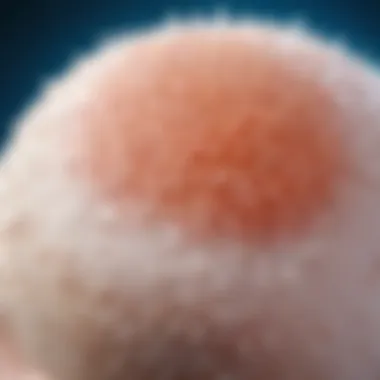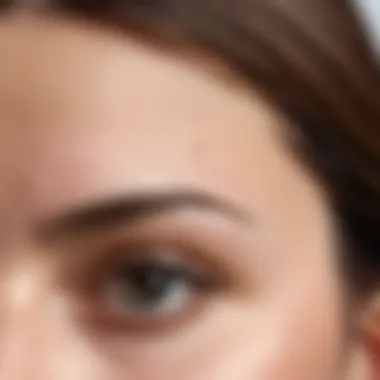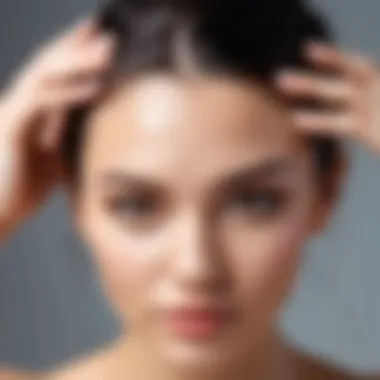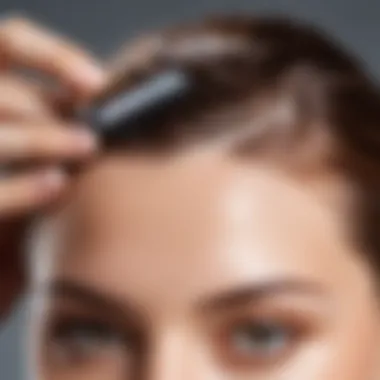Understanding the Causes of Scalp Pimples


Intro
Pimples on the scalp can be an unwelcome and puzzling issue. Many individuals experience them at some point, leaving them to wonder about the underlying causes and how to address the problem effectively. This article aims to yield insight into the various factors contributing to scalp pimples, which can often be overlooked in discussions on skin health. By understanding these causes, individuals can develop tailored personal care practices and consider effective treatments.
Scalp acne, similar to acne on the face or back, arises from clogged pores and can be exacerbated by numerous biological and environmental factors. Understanding this connection is essential, not just for cosmetic reasons, but for overall scalp health. This discussion encompasses common triggers, biological mechanisms, and helpful treatments while promoting informed choices in personal care. Ultimately, it serves as a guide to achieve a healthier scalp and, in turn, possibly improved confidence.
Prolusion
The issue of pimples on the scalp often receives less attention than acne on other parts of the body. However, this condition can significantly affect a person's comfort, confidence, and overall scalp health. Understanding the causes of scalp acne is crucial for effective management and prevention. It is not merely a cosmetic concern; it involves biological processes, environmental factors, and lifestyle choices that must be considered.
In this article, we will break down the complexities surrounding scalp pimples. We will explore how issues like excessive oil production and bacterial activity can lead to these blemishes. Furthermore, hormonal fluctuations and dietary choices can also contribute to this irritation. The knowledge shared here aims to empower individuals to identify triggers and seek appropriate treatment measures, making a profound difference in everyday life.
The significance of this topic stretches beyond mere aesthetic concerns. Scalp health impacts hair growth and general wellbeing. By delving into the various aspects that lead to the emergence of pimples on the scalp, readers will gain a clearer understanding of their own experiences with this issue. Addressing such concerns not only improves individual conditions but also fosters broader insights into personal care and dermatological health.
As we proceed, we will highlight key points regarding the scalp’s anatomy and its relation to acne formation, establish a foundation for discussing the causes, and outline effective preventive measures and treatments. The goal is to provide a comprehensive guide that speaks to both men and women of all ages, ensuring a thorough grasp of this often-overlooked topic.
"A healthy scalp is vital for healthy hair; understanding issues like scalp acne can lead to better hair care choices."
This exploration into scalp acne will ultimately guide readers toward improved scalp care practices and a more profound appreciation for their skin's health.
The Anatomy of the Scalp
Understanding the anatomy of the scalp is essential for comprehending the causes of pimples in this area. The scalp consists of several layers, each contributing to its overall health and function. By exploring the unique characteristics of these layers, we can identify how they may become susceptible to conditions that lead to pimple formation.
The scalp's anatomy is not merely relevant for academic reasons. It gives insights into how to maintain scalp health proactively, which can help prevent issues like acne. Knowledge of the scalp structure helps in selecting appropriate treatments and personal care products.
Skin Structure and Function
The scalp's skin is comprised of multiple layers: the epidermis, dermis, and subcutaneous tissue. The epidermis is the outer layer, serving as a protective barrier against environmental factors. It also houses hair follicles, essential for hair growth. The dermis contains connective tissues, blood vessels, and nerve endings, which play roles in sensation and nourishment. The subcutaneous fat layer serves to insulate and cushion the scalp.
The overall function of this skin includes protecting against pathogens and regulating temperature. It is important to note that these functions can be disrupted by factors like excessive oil production or bacterial growth, both of which can contribute to pimples.
Sebaceous Glands and Their Role
Sebaceous glands are crucial components embedded within the scalp's skin. These glands secrete sebum, an oily substance that moisturizes and protects the hair and scalp. While sebum is beneficial in moderation, overproduction can lead to clogged pores and pimple formation.
Sebum plays a dual role: it prevents dryness while also creating an environment where bacteria can thrive when excessive. If these bacteria proliferate, they can lead to inflammation and infection, resulting in pustules or pimples. Furthermore, understanding the role of sebaceous glands allows individuals to recognize signs of excess sebum, paving the way for better management practices.
"Healthy scalp function is vital for preventing conditions such as acne. Knowledge about sebaceous glands helps target potential problems at the source."
In summary, the anatomy of the scalp, including the skin structure and the role of sebaceous glands, serves as a foundation for understanding scalp health. It elucidates how imbalances can lead to common conditions such as pimples. By appreciating these elements, readers can make informed decisions regarding their scalp care routines.
What Causes Pimples on the Scalp?


Understanding what causes pimples on the scalp is crucial for managing and preventing this condition. Scalp acne can undermine both comfort and confidence, affecting both men and women of all ages. The skin on the scalp is not fundamentally different from that on other areas of the body; it is susceptible to various triggers involving biological functionality and environmental interaction.
Identifying the precise causes can lead to effective treatment strategies. Knowledge about these elements helps individuals tailor their personal care routines and make informed decisions about professional help. This awareness is especially vital in guiding choices related to scalp hygiene and product usage. By dissecting each cause, the article seeks to empower the readers with relevant and actionable insights.
Excess Sebum Production
Excess sebum production is one of the primary causes of pimples on the scalp. Sebum is an oily substance produced by sebaceous glands that keeps skin hydrated. However, overproduction can lead to clogged hair follicles. When these follicles become blocked, they can become inflamed, leading to the formation of pimples. This phenomenon can be exacerbated by factors such as stress, poor diet, and hormonal fluctuations. Maintaining a proper balance in sebum production is essential for preventing acne.
Bacterial Growth
Another significant factor contributing to scalp acne is bacterial growth. The scalp is home to various types of bacteria, some of which are beneficial, while others can trigger inflammation. One common bacterium, Propionibacterium acnes, thrives in oily environments. When excess sebum and dead skin cells accumulate, it can create an ideal breeding ground for this bacterium. This leads to inflammation and, subsequently, the formation of pimples.
Environmental Factors
Environmental elements can also play a critical role in the development of scalp acne. Factors such as pollution, humidity, and sweat can negatively impact scalp health. Individuals residing in urban areas may find their scalps more prone to acne due to exposure to environmental pollutants. Sweating can also contribute to clogged pores, especially when combined with hair products that may leave residues. Identifying and minimizing exposure to such environmental pollutants is crucial in preventing pimples on the scalp.
Hormonal Changes
Hormonal changes can initiate or worsen scalp acne. Fluctuations in hormones, particularly during puberty, menstruation, or pregnancy, can increase sebum production. Additionally, conditions like polycystic ovary syndrome (PCOS) may alter hormonal balances significantly, leading to breakouts. It is essential to recognize personal hormonal patterns and their potential impact on scalp health to address this cause effectively.
Dietary Influences
Diet can significantly influence the condition of the scalp. Consumption of high-glycemic foods, such as white bread and sugary snacks, has been linked to increased acne due to spiking insulin levels, which can lead to heightened oil production. Diets high in dairy have also been associated with acne in certain individuals. Incorporating a balanced diet rich in fruits, vegetables, and omega-3 fatty acids can help mitigate these effects, promoting healthier skin overall.
"Understanding and mitigating the factors leading to scalp acne is essential for preventing future outbreaks and maintaining a healthy scalp."
By examining these causes of pimples on the scalp, individuals can better navigate their scalp health journey. Addressing sebum production, bacterial growth, environmental factors, hormonal changes, and dietary influences establishes a comprehensive approach to managing and preventing scalp acne.
Skin Conditions Associated with Scalp Acne
Understanding skin conditions associated with scalp acne is crucial for anyone dealing with this issue. It provides insights into various skin disorders that can mimic or contribute to pimple formations on the scalp. Recognizing these conditions not only aids in effective treatment but also fosters early intervention.
Each condition has distinct features that set it apart. By identifying the right issues, individuals can seek appropriate remedies, which may include lifestyle changes, skincare products, or professional consultations. A deeper comprehension of these conditions enhances awareness and empowers individuals to take control of their scalp health while minimizing potential complications.
Folliculitis
Folliculitis is an inflammation of the hair follicles. This condition can arise from bacterial or fungal infections that target the scalp's follicles. Symptoms include small, red bumps that can resemble acne. When pustules form, they may be filled with pus, leading to discomfort.
Though not always severe, folliculitis can lead to scarring if left untreated. Personal hygiene plays a role in prevention. Regular cleansing with suitable shampoos can help mitigate excess oil and bacteria buildup. It is essential to avoid scratching, as this can exacerbate the problem. The importance of early diagnosis cannot be stressed enough. Recognizing folliculitis early may allow for effective treatment, preventing more serious issues. If persistent, individuals should consult with a dermatologist for targeted therapy.
Dermatitis
Dermatitis is another common skin condition affecting the scalp. This term refers to several types of skin inflammation. Seborrheic dermatitis, in particular, can trigger oily patches, flakiness, and itching on the scalp. In severe cases, this condition may present a crusted appearance.
Factors contributing to dermatitis include hormonal fluctuations and environmental irritants. Treatment often involves medicated shampoos that reduce flakes and inflammation. Implementing a regular scalp care routine can significantly help. Selecting the right hair products is essential. People should opt for those free of harsh chemicals or fragrances that may irritate the skin.


Psoriasis
Psoriasis is a chronic skin condition characterized by thick, red patches covered with silvery scales. While often associated with dry skin, it can thrive on the scalp, leading to itchiness and discomfort. It affects the skin's ability to regenerate, causing accelerated growth of skin cells.
This condition can be complex, with various triggering factors. Stress, certain medications, and infections can worsen psoriasis symptoms. Treatments range from topical corticosteroids to prescription medications aimed at moderating the immune response. Individuals should actively manage psoriasis through a healthy lifestyle, stress management, and dietary considerations. It is advisable to regularly consult with a healthcare professional to maintain optimal scalp health and address any flare-ups efficiently.
Preventative Measures
Preventing pimples on the scalp is often more effective than treating them after they appear. Proactive measures can significantly minimize the occurrence of scalp acne and promote healthy scalp skin. Understanding these measures allows individuals to take control of their scalp health, reducing discomfort and the potential for scarring.
Regular Scalp Hygiene
Maintaining proper scalp hygiene is crucial. Regular washing helps remove excess oils, dirt, and dead skin cells that can lead to clogged pores. A clean scalp prevents the bacterial growth responsible for acne. Here are some key tips to establish a good scalp hygiene routine:
- Use a gentle shampoo formulated for your hair type.
- Avoid washing your hair too frequently, as this can strip natural oils. Aim for every other day.
- Massage the scalp gently while washing to ensure thorough cleansing.
By adhering to a consistent hygiene routine, individuals lower the risk of scalp issues, including acne. A clean environment is less conducive to the development of skin conditions.
Choosing the Right Hair Products
Product selection plays a significant role in scalp health. Many products contain harsh chemicals that can irritate the skin, leading to acne flare-ups. When selecting hair products, consider the following factors:
- Opt for non-comedogenic products that do not clog pores.
- Choose shampoos without sulfates and parabens. These ingredients can be aggravating to sensitive skin.
- Be wary of heavy oils that can lead to excessive clamminess on the scalp. Instead, look for light-weight formulas, especially if your scalp is oily.
Selecting the correct products tailored to individual skin types can decrease the likelihood of scalp acne.
Diet Adjustments
Diet can impact skin health, including that of the scalp. Certain foods may contribute to hormonal imbalances and inflammation, both of which can trigger acne. Incorporating a balanced diet may help alleviate these issues. Important dietary habits to consider include:
- Increase your intake of fruits and vegetables. Their antioxidants help combat oxidative stress.
- Choose whole grains over refined sugars, as high glycemic foods can exacerbate acne.
- Stay hydrated to maintain skin moisture and flush out toxins. Aim for at least eight glasses of water daily.
Balanced nutrition supports overall skin health and can modify the frequency of scalp pimples.
By thoughtfully selecting food items that nourish rather than harm the scalp, individuals can notice improvements over time.
Treatment Options
When dealing with pimples on the scalp, understanding treatment options is crucial. Each person may respond differently to various treatments. Hence, knowing the available options helps to customize a regime that best suits individual needs. Treatments can alleviate discomfort, minimize pimples, and improve overall scalp health. Below, we explore three primary categories of treatments: over-the-counter solutions, prescription medications, and natural remedies.
Over-the-Counter Solutions
Over-the-counter solutions provide a convenient way to address mild cases of scalp acne. These products often include ingredients that target bacteria, reduce oiliness, and promote healing. Common ingredients found in these treatments include:
- Salicylic Acid: This helps to exfoliate the skin, keeping pores clear and reducing inflammation.
- Benzoyl Peroxide: Effective against bacteria, it also aids in drying out excess oil on the scalp.
- Tea Tree Oil: A natural antiseptic that combats bacteria and fungi, it is praised for its soothing properties.


When using over-the-counter solutions, it's important to carefully follow instructions. Start with a small amount to test for any adverse reactions on the scalp. Regular use is often needed to see significant improvements.
Prescription Medications
For more severe cases, prescription medications might be necessary. Consulting a healthcare professional is advised to determine the best course of action. Common prescription treatments include:
- Topical Retinoids: Such as tretinoin, these can help to unclog pores and reduce inflammation.
- Antibiotics: Either topical or oral, these can reduce bacterial growth and inflammation.
- Isotretinoin: Reserved for severe acne, this powerful medication reduces oil production and has various side effects to consider.
Patients prescribed these medications should have regular follow-ups. Close monitoring helps assess effectiveness and manage side effects, resulting in a tailored treatment plan.
Natural Remedies
Many individuals seek natural remedies due to concerns about side effects or personal preference. While evidence might be less robust, several natural treatments show promise in managing scalp acne:
- Aloe Vera: Known for its soothing properties, it can reduce irritation and redness on the scalp.
- Apple Cider Vinegar: Diluting it and applying it to the scalp can help maintain pH balance and combat bacteria.
- Zinc Supplements: May support skin health and reduce acne severity.
Before adopting any natural remedies, it is advisable to conduct a patch test to ensure no allergic reactions occur. Consulting with a dermatologist can help in integrating these remedies into an existing regimen.
Treatment options vary per individual and diligent testing for efficacy helps achieve the best results.
When to Seek Professional Help
Recognizing when to seek professional help is crucial for anyone dealing with scalp pimples. While many cases may be mild and manageable at home, some conditions warrant a visit to a specialist. Early intervention can prevent further complications and lead to more effective treatment. It's important to be knowledgeable about specific signs and symptoms that may indicate a more serious issue.
Recognizing Serious Conditions
Not every pimple on the scalp is just an everyday blemish. Several conditions may present as scalp acne but require medical assessment. Watch for the following indicators:
- Persistent Pimples: If you notice that pimples do not improve after consistent home treatment, this is a red flag.
- Inflammation or Pain: Increased sensitivity, swelling, or pain in the affected area can signal a more serious underlying condition.
- Scaliness or Flaking: The combination of pustules and flaking skin may indicate conditions such as dermatitis or psoriasis.
- Fever or Systemic Symptoms: Any accompanying systemic symptoms, such as fever or chills, should prompt immediate medical attention.
In summary, being vigilant about the nature of your scalp issues is essential. If the situation intensifies, consulting with a healthcare provider becomes necessary.
Consulting with a Dermatologist
Seeing a dermatologist is often the best course of action when dealing with persistent scalp issues. These professionals have specialized knowledge and training to diagnose and treat skin conditions effectively. Here is why consulting with a dermatologist can be beneficial:
- Accurate Diagnosis: Dermatologists employ various techniques, including visual examination and skin biopsies, to accurately diagnose the root cause of scalp issues.
- Tailored Treatment Plans: Based on the diagnosis, they can recommend specific treatments. This might include prescription medications or specialized shampoos that aren’t available over the counter.
- Preventative Care Advice: A dermatologist can also advise on scalp care routines tailored to individual skin types and conditions, potentially preventing future outbreaks.
- Access to Advanced Treatments: In certain cases, a dermatologist may suggest advanced therapies such as light therapy or systemic medications that can combat severe scalp conditions.
Consulting a professional ensures you have the right tools and information for effective management of scalp health.
Taking these steps can greatly enhance the quality of treatment and overall well-being. Knowing when to seek professional help is instrumental in maintaining a healthy scalp.
Epilogue
Effective treatment options are available, ranging from over-the-counter solutions to natural remedies, ensuring that everyone can find an approach that works for their specific needs. It is crucial for men and women of all ages to pay careful attention to their scalp care practices, which can significantly reduce the occurrence of acne. Regular cleansing, appropriate product selection, and dietary adjustments can create a comprehensive strategy for minimizing outbreaks.
Moreover, knowing when to seek professional help cannot be overstated. Dermatologists can provide valuable insights into persistent issues and serious conditions that may require specialized treatment.
Ultimately, a proactive approach helps to maintain a healthy scalp and reduce the incidence of pimples. Individuals equipped with knowledge about their conditions can make better choices, leading to improved dermatological health and overall well-being.
Understanding the causes of scalp pimples empowers individuals to take control of their scalp health and seek proper solutions.







